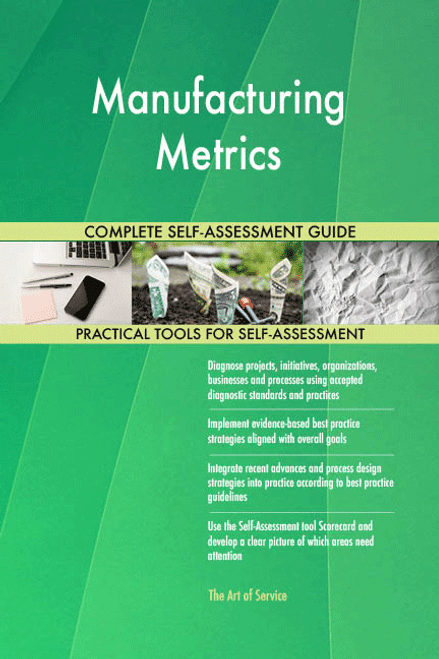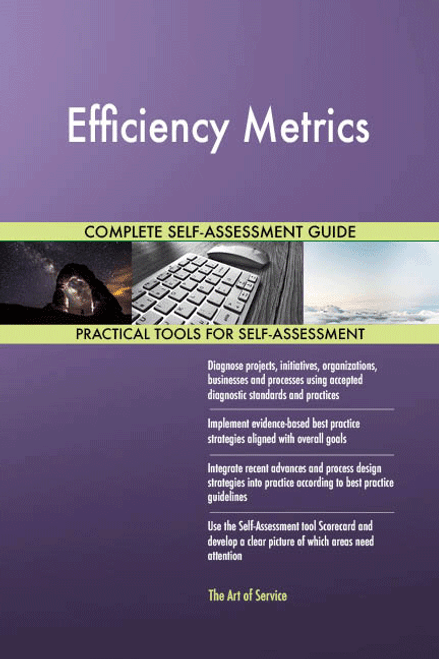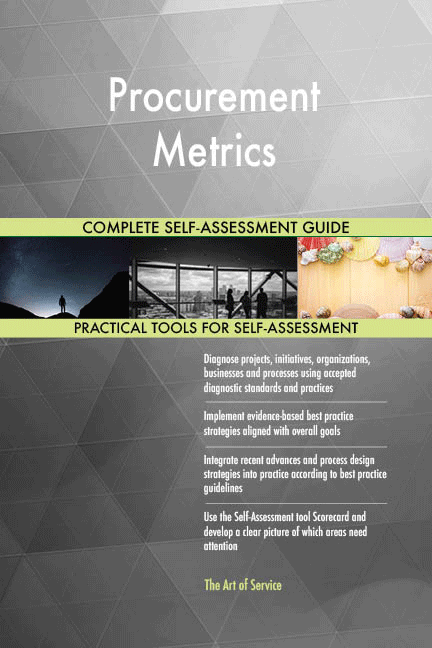Supervise PR Metrics: proactively identify, measure, and analyze operational risks in consumer Retail Services, providing mitigation strategies where appropriate.
More Uses of the PR Metrics Toolkit:
- Identify approach to creating Best Practices and metrics to drive training compliance.
- Support the budget and expenditures of the program and report on utilization, costs and other metrics to measure the programs performance.
- Meet program metrics (retention, training facilitation, attendance) and provide regular metric updates.
- It analytics Customer Support and metrics analysis; troubleshooting and Issue Resolution; itil service support Process Mapping and Process Improvement; communication and interaction with multiple levels of your organization.
- Perform, deliver and own Data Analyses to measure and monitor customer metrics and trends to inform and improve Decision Making and strategy for Key Stakeholders.
- Secure that your design establishes and implements metrics (process capability, Control Charts, measurement quality) for monitoring system effectiveness and to enable managers to make sound Product Quality decisions.
- Utilize Performance Metrics and trends to (proactively) address technology and support issues and improve service.
- Direct PR Metrics: benchmark, track, and analyze annual Performance Metrics and sourcing trends against budget on a monthly basis to demonstrate Continuous Improvement and progress against Strategic Objectives.
- Enable others in your organization to utilize your work by onboarding new metrics into your Self Serve data system and the experimentation platform.
- Be certain that your operation leads quality strategy deployment at it, improving established ways of working and delivering against Key Metrics reflected in your organization business and related Quality Objectives/metrics.
- Secure that your venture creates engineering and operational perfection, establishing metrics and process for assessment and improvements.
- Direct PR Metrics: monitor team performance and provide metrics to upper management on development, contributions, and results.
- Meet established service level metrics detailed in the Service Level Agreement for call response, Technical Support, and Customer Service.
- Maintain metrics on supplier audit findings used for oversight, qualification status, Continuous Improvement, and/or opportunities for reduction/alternate suppliers.
- Support Reporting And Analytics functions to drive value add metrics that highlight breakdowns of third party Information security risk, Team Productivity, and identify opportunities for Process Improvement.
- Confirm your organization analyzes real time daily, weekly, and monthly call Management Metrics and develops action plans in support of metric and labor improvements.
- Confirm your organization stakeholders work with it and thE Business to monitor, review, and facilitate compliance with established policies, procedures, and metrics to ensure that Data Quality is effectively maintained and improved.
- Ensure you support; lead Continual Service Improvement and ongoing Process Maturity through regular review of the process and tools, Trend Analysis and metrics reporting and through regular engagement with stakeholders.
- Ensure you accomplish; understand Performance Metrics and improve quality, speed, and capabilities to meet or exceed goals.
- Provide project updates and metrics on a consistent basis regarding strategy, timeline adjustments, and progress.
- Develop and maintain appropriate tracking and reporting of product Performance Metrics (delivery, user sat, support, etc).
- Coordinate PR Metrics: report on key marketing metrics and track the success of all marketing campaigns and initiatives; conduct ongoing analysis of brand performance and Key Metrics.
- Confirm your team measures, analyze, and reports Performance Metrics and provides timely and accurate monthly reporting of KPIs.
- Warrant that your organization develops, implements and monitors metrics for process effectiveness and efficiency, ensuring smooth integration between all Key Stakeholder groups at a process, people and tool level.
- Ensure you outperform; lead creation, identification, and insights of metrics to improvE Business performance and drivE Business actions.
- Pilot PR Metrics: research, collect, validate, and collate data and information to design, direct, and support the development of accurate and meaningful edw metrics reports.
- Develop Reporting And Analytics dashboards into Data Systems to enhance Operational Efficiency and organizational feedback to provide metrics for Key Performance Indicators (KPIs).
- Determine, implement, and evaluatE Business metrics to meet ongoing organizational or customer Information Needs.
- Establish and continuous monitor Key Metrics of Material Flow integration/automation systems to proactively address issues/inputs negatively impacting performance.
- Confirm your organization utilizes process data and metrics to identify Business Process challenges and recommends Innovative Solutions for improving operation efficiency and effectiveness.
- Manage and mentored a DevOps onsite and offsite engineering for building and implementing Cloud/AWS environment.
Save time, empower your teams and effectively upgrade your processes with access to this practical PR Metrics Toolkit and guide. Address common challenges with best-practice templates, step-by-step Work Plans and maturity diagnostics for any PR Metrics related project.
Download the Toolkit and in Three Steps you will be guided from idea to implementation results.
The Toolkit contains the following practical and powerful enablers with new and updated PR Metrics specific requirements:
STEP 1: Get your bearings
Start with...
- The latest quick edition of the PR Metrics Self Assessment book in PDF containing 49 requirements to perform a quickscan, get an overview and share with stakeholders.
Organized in a Data Driven improvement cycle RDMAICS (Recognize, Define, Measure, Analyze, Improve, Control and Sustain), check the…
- Example pre-filled Self-Assessment Excel Dashboard to get familiar with results generation
Then find your goals...
STEP 2: Set concrete goals, tasks, dates and numbers you can track
Featuring 999 new and updated case-based questions, organized into seven core areas of Process Design, this Self-Assessment will help you identify areas in which PR Metrics improvements can be made.
Examples; 10 of the 999 standard requirements:
- The political context: who holds power?
- Who needs what information?
- How do senior leaders actions reflect a commitment to the organizations PR Metrics values?
- Which information does the PR Metrics Business Case need to include?
- Where do you gather more information?
- Would you rather sell to knowledgeable and informed customers or to uninformed customers?
- Risk events: what are the things that could go wrong?
- What are the PR Metrics tasks and definitions?
- Which PR Metrics solution is appropriate?
- Are the planned controls in place?
Complete the self assessment, on your own or with a team in a workshop setting. Use the workbook together with the self assessment requirements spreadsheet:
- The workbook is the latest in-depth complete edition of the PR Metrics book in PDF containing 994 requirements, which criteria correspond to the criteria in...
Your PR Metrics self-assessment dashboard which gives you your dynamically prioritized projects-ready tool and shows your organization exactly what to do next:
- The Self-Assessment Excel Dashboard; with the PR Metrics Self-Assessment and Scorecard you will develop a clear picture of which PR Metrics areas need attention, which requirements you should focus on and who will be responsible for them:
- Shows your organization instant insight in areas for improvement: Auto generates reports, radar chart for maturity assessment, insights per process and participant and bespoke, ready to use, RACI Matrix
- Gives you a professional Dashboard to guide and perform a thorough PR Metrics Self-Assessment
- Is secure: Ensures offline Data Protection of your Self-Assessment results
- Dynamically prioritized projects-ready RACI Matrix shows your organization exactly what to do next:
STEP 3: Implement, Track, follow up and revise strategy
The outcomes of STEP 2, the self assessment, are the inputs for STEP 3; Start and manage PR Metrics projects with the 62 implementation resources:
- 62 step-by-step PR Metrics Project Management Form Templates covering over 1500 PR Metrics project requirements and success criteria:
Examples; 10 of the check box criteria:
- Cost Management Plan: Eac -estimate at completion, what is the total job expected to cost?
- Activity Cost Estimates: In which phase of the Acquisition Process cycle does source qualifications reside?
- Project Scope Statement: Will all PR Metrics project issues be unconditionally tracked through the Issue Resolution process?
- Closing Process Group: Did the PR Metrics Project Team have enough people to execute the PR Metrics Project Plan?
- Source Selection Criteria: What are the guidelines regarding award without considerations?
- Scope Management Plan: Are Corrective Actions taken when actual results are substantially different from detailed PR Metrics Project Plan (variances)?
- Initiating Process Group: During which stage of Risk planning are risks prioritized based on probability and impact?
- Cost Management Plan: Is your organization certified as a supplier, wholesaler, regular dealer, or manufacturer of corresponding products/supplies?
- Procurement Audit: Was a formal review of tenders received undertaken?
- Activity Cost Estimates: What procedures are put in place regarding bidding and cost comparisons, if any?
Step-by-step and complete PR Metrics Project Management Forms and Templates including check box criteria and templates.
1.0 Initiating Process Group:
- 1.1 PR Metrics project Charter
- 1.2 Stakeholder Register
- 1.3 Stakeholder Analysis Matrix
2.0 Planning Process Group:
- 2.1 PR Metrics Project Management Plan
- 2.2 Scope Management Plan
- 2.3 Requirements Management Plan
- 2.4 Requirements Documentation
- 2.5 Requirements Traceability Matrix
- 2.6 PR Metrics project Scope Statement
- 2.7 Assumption and Constraint Log
- 2.8 Work Breakdown Structure
- 2.9 WBS Dictionary
- 2.10 Schedule Management Plan
- 2.11 Activity List
- 2.12 Activity Attributes
- 2.13 Milestone List
- 2.14 Network Diagram
- 2.15 Activity Resource Requirements
- 2.16 Resource Breakdown Structure
- 2.17 Activity Duration Estimates
- 2.18 Duration Estimating Worksheet
- 2.19 PR Metrics project Schedule
- 2.20 Cost Management Plan
- 2.21 Activity Cost Estimates
- 2.22 Cost Estimating Worksheet
- 2.23 Cost Baseline
- 2.24 Quality Management Plan
- 2.25 Quality Metrics
- 2.26 Process Improvement Plan
- 2.27 Responsibility Assignment Matrix
- 2.28 Roles and Responsibilities
- 2.29 Human Resource Management Plan
- 2.30 Communications Management Plan
- 2.31 Risk Management Plan
- 2.32 Risk Register
- 2.33 Probability and Impact Assessment
- 2.34 Probability and Impact Matrix
- 2.35 Risk Data Sheet
- 2.36 Procurement Management Plan
- 2.37 Source Selection Criteria
- 2.38 Stakeholder Management Plan
- 2.39 Change Management Plan
3.0 Executing Process Group:
- 3.1 Team Member Status Report
- 3.2 Change Request
- 3.3 Change Log
- 3.4 Decision Log
- 3.5 Quality Audit
- 3.6 Team Directory
- 3.7 Team Operating Agreement
- 3.8 Team Performance Assessment
- 3.9 Team Member Performance Assessment
- 3.10 Issue Log
4.0 Monitoring and Controlling Process Group:
- 4.1 PR Metrics project Performance Report
- 4.2 Variance Analysis
- 4.3 Earned Value Status
- 4.4 Risk Audit
- 4.5 Contractor Status Report
- 4.6 Formal Acceptance
5.0 Closing Process Group:
- 5.1 Procurement Audit
- 5.2 Contract Close-Out
- 5.3 PR Metrics project or Phase Close-Out
- 5.4 Lessons Learned
Results
With this Three Step process you will have all the tools you need for any PR Metrics project with this in-depth PR Metrics Toolkit.
In using the Toolkit you will be better able to:
- Diagnose PR Metrics projects, initiatives, organizations, businesses and processes using accepted diagnostic standards and practices
- Implement evidence-based Best Practice strategies aligned with overall goals
- Integrate recent advances in PR Metrics and put Process Design strategies into practice according to Best Practice guidelines
Defining, designing, creating, and implementing a process to solve a business challenge or meet a business objective is the most valuable role; In EVERY company, organization and department.
Unless you are talking a one-time, single-use project within a business, there should be a process. Whether that process is managed and implemented by humans, AI, or a combination of the two, it needs to be designed by someone with a complex enough perspective to ask the right questions. Someone capable of asking the right questions and step back and say, 'What are we really trying to accomplish here? And is there a different way to look at it?'
This Toolkit empowers people to do just that - whether their title is entrepreneur, manager, consultant, (Vice-)President, CxO etc... - they are the people who rule the future. They are the person who asks the right questions to make PR Metrics investments work better.
This PR Metrics All-Inclusive Toolkit enables You to be that person.
Includes lifetime updates
Every self assessment comes with Lifetime Updates and Lifetime Free Updated Books. Lifetime Updates is an industry-first feature which allows you to receive verified self assessment updates, ensuring you always have the most accurate information at your fingertips.







